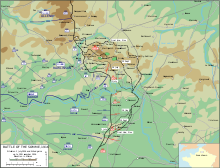
Back Slag van die Somme Afrikaans معركة السوم Arabic Somma döyüşü Azerbaijani سومما دؤیوشو AZB Бітва на Соме Byelorussian Бітва на Соме BE-X-OLD Битка при Сома Bulgarian Emgann ar Somme Breton Bitka na Somi (1916) BS Batalla del Somme Catalan
| Battle of the Somme | |||||||||
|---|---|---|---|---|---|---|---|---|---|
| Part of the Western Front of the First World War | |||||||||
 Complete map of the Battle of the Somme | |||||||||
| |||||||||
| Belligerents | |||||||||
|
|
| ||||||||
| Commanders and leaders | |||||||||
|
|
| ||||||||
| Strength | |||||||||
|
1 July July–November |
1 July July–November | ||||||||
| Casualties and losses | |||||||||
|
(95,675 killed or missing) (50,729 killed or missing) |
41,605 men captured by French[4] 31,396 men captured by British[4] | ||||||||
The Battle of the Somme (French: Bataille de la Somme; German: Schlacht an der Somme), also known as the Somme offensive, was a major battle of the First World War fought by the armies of the British Empire and the French Third Republic against the German Empire. It took place between 1 July and 18 November 1916 on both sides of the upper reaches of the river Somme in France. The battle was intended to hasten a victory for the Allies. More than three million men fought in the battle, of whom more than one million were either wounded or killed, making it one of the deadliest battles in all of human history.
The French and British had committed themselves to an offensive on the Somme during the Chantilly Conference in December 1915. The Allies agreed upon a strategy of combined offensives against the Central Powers in 1916 by the French, Russian, British and Italian armies, with the Somme offensive as the Franco-British contribution. Initial plans called for the French army to undertake the main part of the Somme offensive, supported on the northern flank by the Fourth Army of the British Expeditionary Force (BEF). When the Imperial German Army began the Battle of Verdun on the Meuse on 21 February 1916, French commanders diverted many of the divisions intended for the Somme and the "supporting" attack by the British became the principal effort. The British troops on the Somme comprised a mixture of the remains of the pre-war army, the Territorial Force and Kitchener's Army, a force of wartime volunteers.
On the first day on the Somme (1 July) the German 2nd Army suffered a serious defeat opposite the French Sixth Army, from Foucaucourt-en-Santerre south of the Somme to Maricourt on the north bank and by the Fourth Army from Maricourt to the vicinity of the Albert–Bapaume road. The 57,470 casualties suffered by the British, including 19,240 killed, were the worst in the history of the British Army. Most of the British casualties were suffered on the front between the Albert–Bapaume road and Gommecourt to the north, which was the area where the principal German defensive effort (Schwerpunkt) was made. The battle became notable for the importance of air power and the first use of the tank in September but these were a product of new technology and proved unreliable.
At the end of the battle, British and French forces had penetrated 6 mi (10 km) into German-occupied territory along the majority of the front, their largest territorial gain since the First Battle of the Marne in 1914. The operational objectives of the Anglo-French armies were unfulfilled, as they failed to capture Péronne and Bapaume, where the German armies maintained their positions over the winter. British attacks in the Ancre valley resumed in January 1917 and forced the Germans into local withdrawals to reserve lines in February before the strategic retreat by about 25 mi (40 km) in Operation Alberich to the Siegfriedstellung (Hindenburg Line) in March 1917. Debate continues over the necessity, significance, and effect of the battle.
- ^ Sheldon 2006, p. 398; Sheffield 2011, pp. 194, 197; Philpott 2009, p. 602–603.
- ^ Doughty 2005, p. 309; Harris 2009, pp. 271; Philpott 2009, p. 602–603.
- ^ Wendt 1931, p. 246; Harris 2009, pp. 271; Philpott 2009, p. 602–603.
- ^ a b Philpott 2009, p. 438.
© MMXXIII Rich X Search. We shall prevail. All rights reserved. Rich X Search